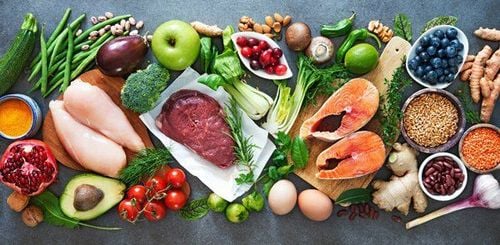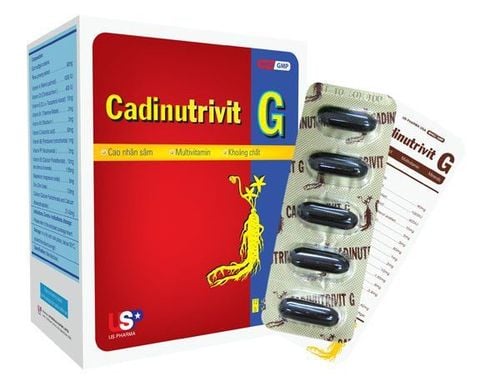This is an automatically translated article.
Children's anorexia, difficulty in absorption and malnutrition are the concerns of many parents. So how to take care of malnourished children? What is the best food for malnourished children? The following article will help you get the answer.
1. Causes of malnutrition in young children
Malnutrition in children is common between 6 and 24 months old, this is a period when children have high nutritional needs, are learning to adapt to the environment and are very sensitive to diseases. Malnutrition is a condition in which the body is not provided with adequate energy, especially protein as well as other trace elements to ensure the body's normal development. Malnutrition is considered a medical condition and is commonly seen in children under 3 years of age.
Malnutrition in children can stem from many different causes. The causes of malnutrition may include:
Due to nutrition: Raising children improperly; the child is not fully breastfed when the mother lacks or loses milk; giving children solid foods or complementary foods in the wrong way because of lack of knowledge or no time to take care of children. Due to prolonged illness: Children with diseases related to respiratory tract infections, repeated gastrointestinal infections, complications after pneumonia, measles, dysentery ... Due to physical abnormalities: Premature babies, fetal malnutrition, cleft lip and palate defects, congenital heart defects. Due to socio-economic conditions: Malnutrition is a disease that is considered poor and backward, related to economy, culture and people's knowledge. This is a typical disease pattern and usually occurs only in developing countries. To know if their children are malnourished or not, mothers need to regularly monitor their children's weight on the daily growth chart. If your baby is still not gaining weight for 2 to 3 months in a row, you need to see a doctor to find out the cause.
According to weight/age criteria, malnutrition is divided into 3 degrees as follows:
For malnourished grade I: Weight remains 90% of age For malnutrition grade II: Weight remains 75% compared to age For malnourished grade III: Weight is less than 60% compared to age In addition, mothers can also pay attention to the typical signs of malnourished children below to prevent the situation. This happens to my child:
Not gaining weight normally or even losing weight Bland, atrophy in arm fat Shrinking or loss of subcutaneous fat. Blue skin, thinning hair that breaks easily and changes color. Poor appetite, or digestive disorders: Passing of raw stools, diarrhea and this tends to be repeated many times Severe malnutrition in children may experience edema, atrophy or manifestations of Vitamin deficiency causes night blindness, corneal dryness to corneal ulcers. Nowadays, severe form is very rare.

Giải đáp trẻ suy dinh dưỡng ăn gì?
2. What do malnourished children eat?
Experts recommend that it is better not to let children suffer from malnutrition, because this can affect the normal development of the baby, even leaving unpredictable consequences later. However, if the child is already malnourished, “how to take care of malnourished children? Or give malnourished children what to drink, what to eat?" also very important.
In order to end malnutrition in children or minimize the effects of malnutrition on children, parents need to supplement children with necessary nutrients, especially those of basic groups of nutrients. Children's bodies are lacking through daily meals by the right foods. The group of malnourished children that need to be supplemented includes:
Fat Fat is an important group of nutrients that must be included in the menu for malnourished children.
Fat helps provide most of the essential energy for the body to function throughout the day, and at the same time creates fat layers that keep the body warm. The fatty acids in foods also work to prevent blood clotting, stimulate the brain activity of children, support and enhance the absorption of vitamins as well as have a quick wound healing effect.
Plant and animal protein Protein is an extremely important component for the development of children. Protein plays a role in forming and replacing damaged cells, helping to prevent malnutrition effectively. Protein is also a component of muscle, blood, lymph, hormones, enzymes, antibodies and excretory and endocrine glands. Thanks to protein, children's resistance is increased, providing energy for their normal activities. In addition, protein is also involved in the metabolism of vitamins and other nutrients.
Calcium Calcium is the most important mineral to help children develop bones and joints and increase height in a normal and stable way. Besides, calcium is also involved in the maintenance of muscles, nervous system, hair and nails. The addition of calcium to the care regimen of malnourished children can help children to be more active, agile, tall and intelligent.
Vitamin A In addition to the nutrients mentioned above, malnourished children also need to add vitamin A to their diets. Vitamin A works to increase resistance and immune system to help children limit diseases. Vitamin A deficiency makes children susceptible to infections, increasing the risk of malnutrition in children.
Vitamin D Vitamin D is a type of vitamin that works to support the transport of calcium into the blood to help the body absorb calcium better. A child's body with vitamin D deficiency can affect the process of bone formation, the intestines do not absorb enough calcium and phosphorus, reducing blood calcium and increasing the risk of malnutrition.
Vitamin C Vitamin C is a substance that helps strengthen the immune system to help the baby stay healthy, strengthens the collagen for the baby's skin to be firm and elastic. Vitamin C also participates in the transmission of nerve impulses, and at the same time enhances the absorption of folic acid, iron and calcium, effectively improving the symptoms of malnutrition.
Zinc Zinc is a substance involved in the process of blood formation, helping to make the baby look rosy and healthier. Providing enough zinc also helps children increase resistance, increase intelligence, limit infections and stimulate appetite in young children.

Trẻ cần được bổ sung những nhóm dưỡng chất đang thiếu hụt thông qua các thực phẩm phù hợp
3. Foods that should be used in taking care of malnourished children
Corresponding to the nutrients, malnourished children need to supplement with the following foods:
Milk and dairy products Milk and dairy products play an extremely important role for children with malnutrition. nutrition, stunting. Milk and dairy products such as cheese, yogurt are rich in calcium and fat (two very important ingredients to improve the nutritional status of your baby). For children who are not malnourished, experts still recommend drinking a glass of milk a day to help the body become healthier, the baby grows taller and stimulates the brain to work effectively.
White rice Rice contains a high starch content, which helps provide energy for children to function all day long. In addition, in white rice also contains a lot of nutrients such as protein, thiamin, vitamin B1, vitamin K and iron. These are all important nutrients necessary for the comprehensive physical and brain development of children.
Children who are malnourished should eat more rice in their main meals every day. If the children are bored and do not want to eat rice, parents can prepare it in the form of thin porridge cooked with meat to make it easier for the baby to eat. Potatoes Potatoes are foods rich in natural glucose, along with a very high content of fiber, vitamin C, vitamin B6 and folic acid. Including potatoes in the daily menu helps children improve their resistance, limit infections and infections, and at the same time enhance the absorption of nutrients in the body more effectively - this is especially true. especially important for malnourished children.
In addition, potatoes are foods that can be processed a lot of nutritious dishes to help treat and prevent malnutrition in children. Mothers can prepare many dishes from potatoes to change the taste and stimulate the baby's appetite.
Pork Pork is a popular dish often in every family meal because it has high nutritional content and reasonable price. Pork contains many vitamins, the most significant of which are vitamin A and vitamin E to help strengthen the immune system and resistance for children. The nutrients in pork are essential for the growth and repair of muscles and nerve tissues, and are involved in the hematopoietic process.
Beef Beef is often used to nourish sick people who have just gotten sick and people with weak health or people who are malnourished. This type of food helps to improve resistance, build a strong immune system and help limit diseases in children. The iron content in beef is also proven to be very abundant, helping to support the effective hematopoietic process, and also contains substances such as zinc, magnesium, protein, and calcium, which also help restore health quickly. Stir-fried beef with vegetables, beef steak, and braised beef with bread are delicious and nutritious dishes that children absolutely love.
Shrimp, crab, fish Seafood in general and common foods such as shrimp, crab and fish are essential in meals for children, especially those who are malnourished.
Shrimp, crab and fish are foods rich in calcium to help children increase height quickly and effectively. Eating these foods regularly will help your baby grow taller, flexible muscles, stronger teeth and hair.
There are many dishes made from shrimp and fish that mothers can process and change in the menu for malnourished children every day such as fish soup, steamed fish, crab soup, roasted shrimp, pork belly only...
Eggs Eggs are considered one of the most perfect foods because they contain high levels of protein and natural fats, bringing many benefits to the body. Eating 3-5 eggs a week can help your baby increase height and stimulate brain development.
Eggs are also one of the easiest foods to prepare, easy to combine with other foods.
Quail According to Oriental Medicine, quail has a sweet taste, is average, has the ability to nourish the five organs, to nourish the spleen, to nourish the mind, and to keep the body safe, very suitable for children who are in a state of malnutrition.
Proper processing of quail will help your baby sleep well, enhance blood circulation, treat symptoms of diarrhea and constipation for a long time. Mothers should stew quail with some traditional herbs to nourish the baby to recover his health.
Grains Grains are products made from grains such as wheat, sesame, corn, beans.... In addition to energy-providing starch, cereals contain high levels of fiber and are good for digestion. chemical. Besides, the cereals from black sesame also contain a lot of nutrients such as Protein, Lipid, Calcium, Phosphorus, Iron... all very essential for the young body. You can use cereal mixed with milk to make breakfast for your baby, which is both convenient and delicious.
Green vegetables Green vegetables are an indispensable food in every child's meal. Green vegetables contain extremely high amounts of calcium and vitamins, especially dark green vegetables. This type of food is also rich in fiber, which helps support the baby's digestion to work better.
The vegetables that should be enhanced for the baby to eat to supplement nutrients can be amaranth, spinach, broccoli... Mother should combine these vegetables with meats to help the dish. delicious and attractive to younger children.
Malnutrition is one of the common diseases in developing countries, especially childhood malnutrition. Malnutrition can have serious consequences for the age group that is considered the future of the world, so the prevention and care of malnourished children is a top priority.
Malnourished children should be supplemented with all necessary groups of nutrients through dishes in their daily meals. In addition, mothers should also pay attention to change the dishes every day to stimulate the child's appetite, avoiding boredom in each meal that may cause children to lose their appetite and skip meals.
Besides, to prevent this, your baby needs to add necessary micronutrients: Zinc, selenium, chromium, Vitamins B1 and B6, Ginger, acerola fruit extract (vitamin C),... to improve taste, eat well, reach the correct height and weight, and exceed the standard, have a good immune system, strengthen the resistance to get sick less often and have less digestive problems.
The improvement of symptoms can take place for a long time, so it is recommended that parents be calm and persistent when supplementing with nutrients for children, even through eating or functional foods. In particular, the use of functional foods should choose those of natural origin that are easily absorbed, do not allow simultaneous use of many types or continuously change the types of functional foods.
For more nutritional knowledge and child care for each age, parents should regularly visit the website vimec.com and make an appointment with the leading doctors, pediatric and nutrition experts of the National General Hospital. Vinmec when needing advice on children's health.













